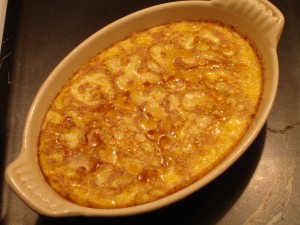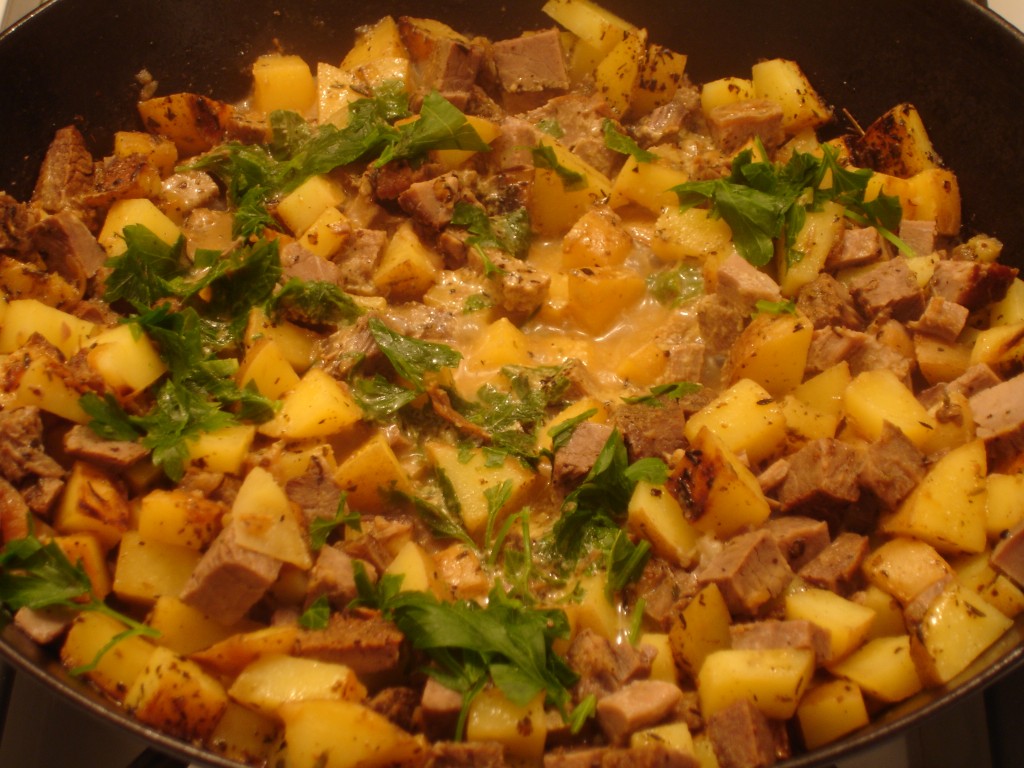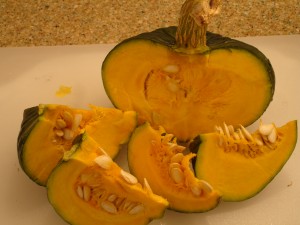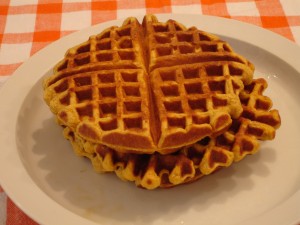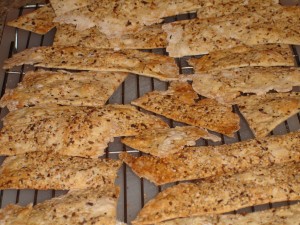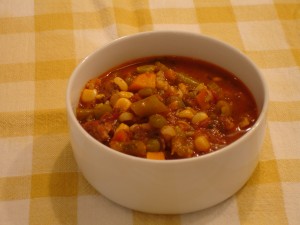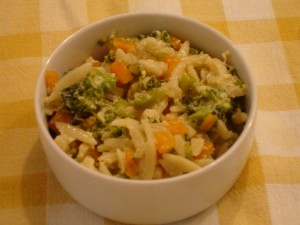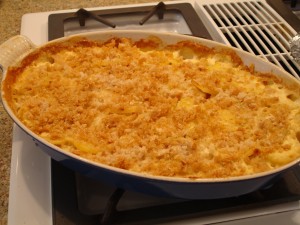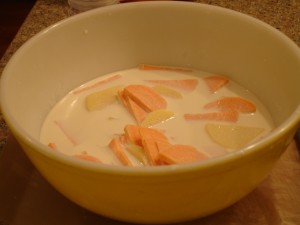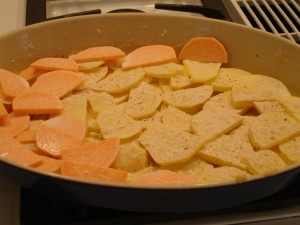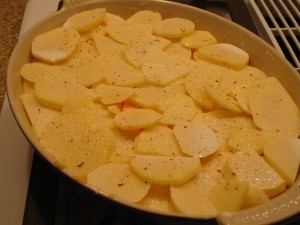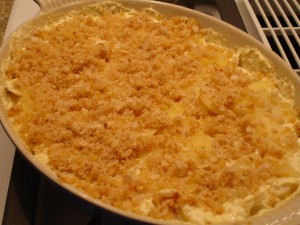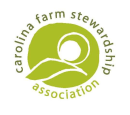I served a cobbler at Raleigh’s Midtown Farmers’ Market a couple of weeks ago. It was made from NC apples, some local pears (and some not so local, but organic), cranberries (sorry – can’t get ’em local) along with my skillet granola crumb topping. It is wonderful for breakfast with a cup of rooibus tea or as a side dish to a pork roast as the weather just starts to turn chilly and many of you asked for the recipe.
It took me a bit longer to post this recipe than I planned because I wanted to get the refined sugar amount down a bit more and I had to experiment with the cranberries a few times to adapt the original recipe. The apples and pears don’t really require any sugar if you pick more sweet varieties and have multiple types to increase the range of flavor in the dish. You might try using a bit of date sugar in them if you really want to mix it up.
Everybody knows how tart cranberries can be and they are pesky to work with although the natural pectin is a delight in a dish like this. I found that cooking them in a bit of apple cider allowed me to reduce the refined sugar down to 2.5 tablespoons for the filling. You still get some tartness from the cranberries, but the sweetness is really provided by the apple cider and the other fruits as this dish bakes. I also added some dehydrated apple pieces to the filling to absorb any additional juices that might occur during cooking. That works well to keep the liquid to a minimum and you might try it the next time you make an apple pie to keep your bottom crust from getting too soggy. I made a couple of additional recipe notes for gluten and lactose free at the bottom.
Sorry for the delay but I hope you will find this an easy recipe to make. I have tested freezing the filling after I completed cooking it and then thawing it to make the rest of the cobbler. And, I’ve tested making the entire cobbler, cooking it and then freezing it so you just reheat it at a later date. Both methods worked well so figure out how much storage you have and make this at the height of the season when the fruit is plentiful and less expensive.

Apple, Pear & Cranberry Cobbler
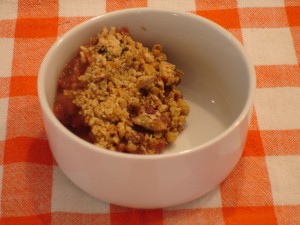
Apple, Pear & Cranberry Cobbler
Apple Cranberry Cobbler
Fruit Filling
- 1 cup fresh or frozen cranberries – unsweetened, chopped in half/quarters
- 2 ½ tablespoons light brown sugar
- ½ cup apple cider
- 1 ½-2 lbs variety of local apples, peeled and sliced ½” thick
- ¾-1 lb variety of local pears, peeled and sliced ½” thick
- 1 teaspoon fresh lemon juice
- ¼ teaspoon nutmeg
- ¼ teaspoon cinnamon
- ½ cup sweetened dried cherries
- ¼ cup dried apples (or pears)
Topping
- ¾ cup wheat/white flour
- 1/6 cup packed dark brown sugar
- ¼ teaspoon salt
- 1 teaspoon baking powder
- 2 ½ tablespoons unsalted butter
- ¼ cup sour cream (low-fat is fine)
- 1 cup Skillet Granola
- ¼ cup chopped pecans or walnuts
As you slice the pears and apples, mix them with the lemon juice to keep them from browning before you cook them.
Bring the cranberries, sugar and ¼ cup of the apple cider to a slow simmer over medium heat and stir until the cranberries are soft and the mixture is like thin jam. If you like dried cherries, you can add them to this part of the process to intensify the cranberry flavor. You may need a bit more apple cider, so keep an eye on the liquid as you cook. This takes from 5-10 minutes. Stir, so it does not burn or stick. A stainless pot is best for this process
Put the cranberry mixture into a bowl, wipe the pot with a wet paper towel and use the same pot to cook the apples and pears in ¼ cup of apple cider along with the nutmeg & cinnamon. You will just cook this just a little bit to set the fruit for freezing and to release a bit of their natural juices. Cook these on medium-high heat until the apples just start to soften. This won’t take long. If the apples are not juicy, then use more cider or juice to keep the mixture from burning. You can also add a bit of butter (2 teaspoons) or date sugar at this point, but it’s not necessary unless you like the flavor.
When both steps are finished, mix all of the fruit together and you can freeze it at this point for up to 3 months, or refrigerate it for up to 3 days, or continue to add the topping and bake. (Do not add the dried apples/pears yet.) I have not measured the pH of this mixture so I don’t know if it’s appropriate to can this mixture at this point.
For the topping, mix the flour, sugar, baking powder and salt together using a whisk to break up clumps. Then cut in butter with a pastry cutter, your fingers (which is melt the butter a bit) or a food processor. You are trying to have small clumps of butter left so they melt as the topping is baking. Then add in the sour cream. Lastly, add in the granola and the extra nuts. The mixture will be very clumping and seem difficult to work with at this point.
To continue, butter the outside and bottom of a pan (this can be a simple aluminum pan or a heavier baking dish. If you use a heavy baking dish please keep an eye on the bake time as some dishes tend to hold heat and bake faster.
Add some of the filling to the pan and then spread the dried apples or pears on top of that so they absorb extra juices as the cobbler cooks. Then add the remainder of the filling and add the granola topping. Just grab little pieces of the topping and spread it over the top of the cobbler trying to cover most of it with an even amount. Don’t worry about making it pretty. Just keep the depth of the topping even so you don’t under or over cook parts of the top.
Now bake it in a pre-heated at 350F oven for 40 minutes, covered with foil. Uncover and continue to bake for 20 minutes until the topping is just starting to brown. Don’t overcook the topping or the cobbler will be dry.
A Couple of Cooking Notes:
This cobbler is not terribly sweet and if you decide to add some vanilla ice cream it will seem appropriately sweet. I frequently use a coconut base ice cream for lactose free friends and it works well with these flavors. If you prefer it without ice cream then you might want to try the filling before you bake the cobbler and add more sugar if you prefer it sweeter to at that step. You can try adding date sugar which gives it more depth also.
If you need a gluten free cobbler, then just use the skillet granola topping but I would add it after the cobbler bakes for about 30 minutes (covered) and watch the cobbler for the next 15-20 minutes as it bakes uncovered to make sure the granola doesn’t burn. Or bake the filling plain and serve it with granola and ice-cream.
Re-heating is easy. Just leave the frozen or refrigerated cobbler covered, bring it to room temperature and bake it, covered, for about 20-30 minutes until it’s warm. Serve right away.

